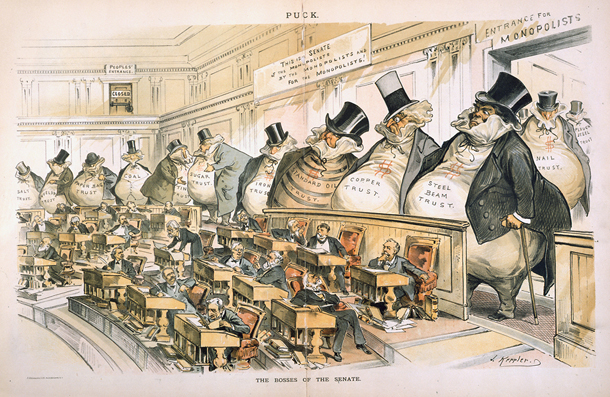LAD/Blog #29: Clayton Anti-Trust Act
LAD/Blog #29: Clayton Anti-Trust Act
The complicated Clayton Anti-Trust Act was created to strengthen the vaguer Sherman Anti-Trust Act of 1890. It gave the government more power to act against trusts. Being much more detailed than its earlier counterpart, the Clayton Anti-Trust Act had five major points: ending price fixing, stopping unfair tying and exclusive dealing practices, giving private parties more power to sue, permitted labor unions to form, and ended “anticompetitive mergers.” This act contained many more nuances to stop the overwhelming power of big businesses, and also protected the public by exempting labor unions from the Sherman Anti-Trust Act. The Federal Trade Commission was created in 1914 through the Federal Trade Commission Act. This played a role in halting the power of trusts, and helped to enforce the Clayton Anti-Trust Act. Mainly, it was (and is) responsible for keeping businesses and their competitions fair. The Antitrust Division of the US Department of Justice (created in 1919) is also used to enforce this act and stop unfair business practices.

Clayton Anti-Trust Act

Anti-Trust Legislation: Sherman Anti-Trust Act/Mann-Elkins Act (synthesis):
There were a few anti-trust laws passed to avoid the scenario depicted in the cartoon. The Sherman Anti-Trust Act was established in 1890 to, like the Clayton Anti-Trust Act, regulate and reduce the power of big businesses and trusts. The Mann-Elkins Act (1910) was created specifically to regulate the communication/railroad industries, so no businesses could have too much control (as it set railroad rates). This went along with the ideas of the Clayton Anti-Trust Act.

The complicated Clayton Anti-Trust Act was created to strengthen the vaguer Sherman Anti-Trust Act of 1890. It gave the government more power to act against trusts. Being much more detailed than its earlier counterpart, the Clayton Anti-Trust Act had five major points: ending price fixing, stopping unfair tying and exclusive dealing practices, giving private parties more power to sue, permitted labor unions to form, and ended “anticompetitive mergers.” This act contained many more nuances to stop the overwhelming power of big businesses, and also protected the public by exempting labor unions from the Sherman Anti-Trust Act. The Federal Trade Commission was created in 1914 through the Federal Trade Commission Act. This played a role in halting the power of trusts, and helped to enforce the Clayton Anti-Trust Act. Mainly, it was (and is) responsible for keeping businesses and their competitions fair. The Antitrust Division of the US Department of Justice (created in 1919) is also used to enforce this act and stop unfair business practices.

Clayton Anti-Trust Act

Anti-Trust Legislation: Sherman Anti-Trust Act/Mann-Elkins Act (synthesis):
There were a few anti-trust laws passed to avoid the scenario depicted in the cartoon. The Sherman Anti-Trust Act was established in 1890 to, like the Clayton Anti-Trust Act, regulate and reduce the power of big businesses and trusts. The Mann-Elkins Act (1910) was created specifically to regulate the communication/railroad industries, so no businesses could have too much control (as it set railroad rates). This went along with the ideas of the Clayton Anti-Trust Act.
Comments
Post a Comment